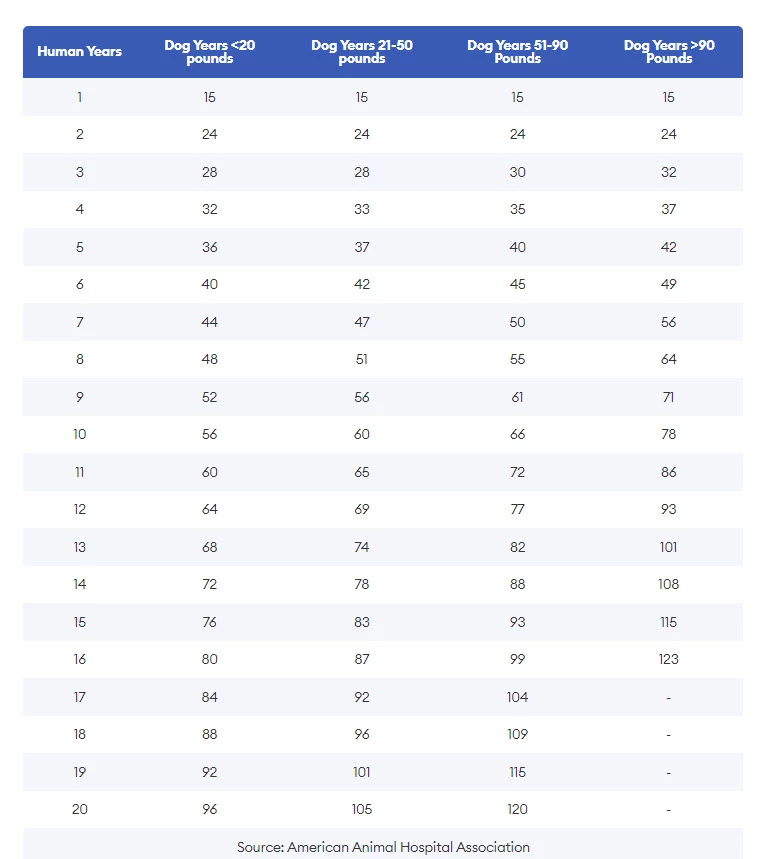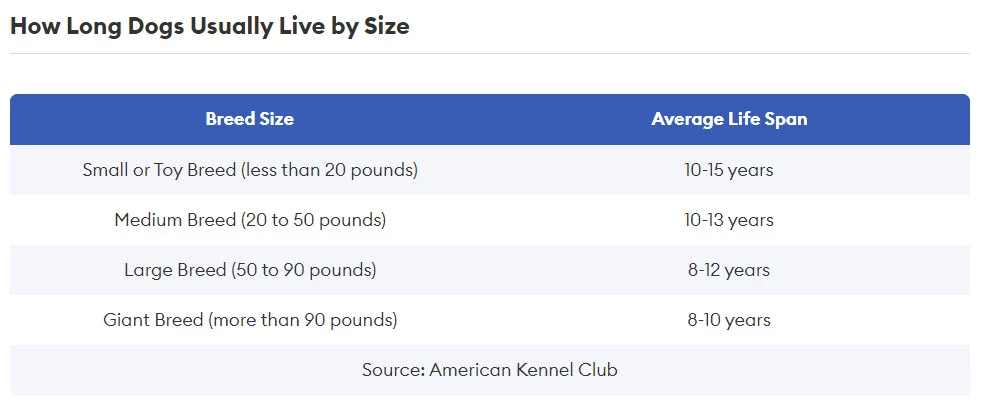
A wish shared by most canine guardians is for their beloved companion to defy the odds and achieve eternal life. Regrettably, our four-legged friends are not endowed with immortality. Moreover, it has come to light that we have been miscalculating the actual ages of our cherished pets for countless years. The commonly employed method of multiplying a dog’s age by seven to ascertain their human equivalent has been conclusively disproven. As revealed by the American Animal Hospital Association, the first year of a dog’s existence is in fact equivalent to 15 human years. Furthermore, the process of canine aging varies among breeds and sizes. Let us now delve into the intricacies of how dogs age and explore the measures one can undertake to promote their longevity and well-being.
The flawed myth that 1 dog year is equivalent to 7 human years has an unclear origin;
Dr. Wendy Hauser, D.V.M., the founder of Peak Veterinary Consulting and advisor to ASPCA Pet Health Insurance, explains that one reason this myth is flawed is because it does not consider the size differences among dogs. Smaller breeds tend to have longer lifespans compared to larger breeds.
A study conducted in 2013 analyzed 74 different dog breeds and their mortality rates. The research revealed that larger dogs have shorter lifespans due to faster aging compared to smaller dogs.
Nicole Ellis, a certified professional dog trainer and pet lifestyle expert with Rover, states that dog aging is not a precise process and varies from dog to dog. Dogs tend to mature rapidly in their early years, but their aging slows down in later years. As a result, not all years can be considered equal in terms of dog age.
Ellis believes that this myth emerged to illustrate the importance of annual veterinary visits for pet owners. It serves as a reminder that dogs age much faster than humans, and a lot can change within a year, emphasizing the significance of routine check-ups with a veterinarian.
Dogs’ Aging Process: An Overview

– Puppyhood: From birth to 6-9 months, depending on the breed and size, this stage marks the end of rapid growth.
– Young Adulthood: Spanning from 6-9 months to 3-4 years, this stage denotes the completion of physical and social maturation.
– Mature Adulthood: Taking place between 3-4 years and the beginning of the last quarter of the estimated life span, this stage differs depending on the breed and size.
– Senior Stage: In the last 25% of the estimated life span, this stage signifies the progression towards the end-of-life phase.
– End-of-life: This terminal stage is characterized by specific pathologies and varies in duration.
Dr. Heather Berst, D.V.M., the medical lead at Zoetis, a producer of medicine and vaccines for pets and livestock, explains the aging process of dogs as comparable to humans but occurring at an accelerated pace.
Within a single year, noticeable changes can be observed in a dog’s behavior, from running and playing to experiencing difficulties getting up due to osteoarthritis. Visible signs of aging usually include the graying of the muzzle, alterations in vision, and reduced mobility.
In the pursuit of a better understanding of how dogs age, scientists and researchers are dedicated to further exploration. Recently, a team of medical and veterinary experts from across the country introduced a more precise method of measuring the physiological age of Labrador retrievers by analyzing their genetic information. Nonetheless, the applicability of this formula to different breeds and sizes of dogs remains uncertain, as noted by the scientists themselves.

The current oldest dog on record is Bobi, a purebred Rafeiro do Alentejo, a Portuguese breed of livestock guardian dog. Bobi turned 31 in May 2023.
The time when dogs are categorized as seniors varies depending on their breed and size.
According to Dr. Jeanne-Pierre Lautier, D.V.M., a veterinarian and consultant for pet care company AB7 Group/Alzoo, the life expectancy of dogs greatly depends on their breed. Large and giant breeds, in particular, have a relatively short life expectancy of around 8 years. These breeds are considered seniors when they reach 7 years of age, requiring closer veterinary supervision.
In order to determine when a dog is considered senior, the American Animal Hospital Association (AAHA) suggests looking at the last 25% of their estimated life span for their specific breed. The following age ranges apply:
– Small or toy breeds (less than 20 pounds): 8 to 11 years
– Medium breeds (20 to 50 pounds): 8 to 10 years
– Large breeds (50 to 90 pounds): 8 to 9 years
– Giant breeds (more than 90 pounds): 6 to 7 years
To help ensure your dog lives a long and healthy life, owners should practice the following:
Copyright © 2020 USA Service Dog. All rights reserved.
As a 56 year old disabled man, my two dogs are my only family ( that I see or talk to) and they are my life, and I would do anything in the world to take care of them! They absolutely saved my life from major depression! The love and devotion they give me is absolutely priceless! Their loyalty to me is undescribable, I am a grumpy ol guy and they always overlook my mad fits and compete for my affection and tolerate each other simply because they know that’s what I want. No one could ever convince me that dogs don’t have feelings, because I know they absolutely do! I thank God for being blessed with these 2 dogs. Mia is a 4 year Australian Kelpie, and Sugar is a approximate 1 year old Min Pin and most likely a bit of a mix breed. As a disabled person I don’t have much money but I do my best for them because they devote their all to me! I do have a Awesome Veterinarian though! Thanks for listening to my rambling. Sincerely, Robert in Missouri
My Missy is almost 2 years old. She is my emotional support puppy. I still think she’s a puppy because she acts just like a spoiled 2-3 year old child. She is a Pekapoo and she really believes she’s human. It’s just the two of us. She helped me through a very dark time of my life…a divorce. We were meant for each other. When we met at the pet store it was by happenstance. Her brother had been purchased bot she was not because she had an umbilical hernia. The Sunday we met she was in a cage by herself because she would not interact with any of the other puppies. I asked to hold her. She layed her little head on my shoulders and we both cried. I bought her right then. She is healthy, happy, very intelligent, loves to play with her toys and my god-son who is six and autistic. He calls her his little sister. They adore each other. I thank God for her.
Our Chihuahua at 15. 2 ( he was at the vet today, lol) is 15 years old. What a true blessing from your chart.
Good night and God bless
I have two dogs. One is pointer/lab and was a rescue and gave blood to save another. He was in bad shape when we got him but we had just lost our 15 yr old black lab months before. He was well-cared for but passed at 15 yrs. Now, this pointer/lab is a sweetheart ❤️ and we have the same amazing vet and he(the dog) loves going to the vet.
My second is a purebred chocolate lab. So handsome and has championship bloodlines to his great grandparents. All have won for showmanship. I have made sure I know basic training and both are service animals for my physical disability. They are brothers if they ever could be.
And both love the cats as well. The cat plays with both and sleeps with them too.
I cannot imagine my life without them. Just like children. I’ve had my chocolate lab since my birthday last year and he was 17 weeks old. Growing so fast.
They are the loves of my life. My fur babies 👶 🧸🐕🦮🐕🦺